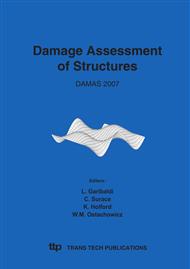p.427
p.435
p.441
p.447
p.455
p.461
p.467
p.473
p.479
Using the Detection and Relative Damage Quantification Indicator (DRQ) with Transmissibility
Abstract:
The Detection and Relative Damage Quantification Indicator (DRQ) was presented previously as a reliable damage detection indicator when used with Operational Deflection Shapes (ODS). The DRQ was computed from the Response Vector Assurance Criterion (RVAC) between the damaged and the initial ODS and the resulting value proved to be a good indicator of the presence of damage. The use of the ODS implies that the loads applied to the structure with and without damage are either known or, at least, the same. If the forces are not deterministic but still ergodic, the power spectrum could be used to evaluate the ODS, but still the above conditions hold, in a statistical sense. When a structure is subjected to ambient excitation, those conditions can hardly be assured. The loads may vary quite significantly and the ODS changes may be due to those changes instead of the presence of damage. To avoid this handicap, the authors explore here the use of the Transmissibility functions. If properly defined, the Transmissibility is invariant with respect to the amplitude of the loads. Since the Displacement Transmissibility is load invariant, a picked set of responses can be measured in service and used to predict another set; the result will then be correlated to the actual values using the RVAC and the DRQ will be computed. Numerical and experimental examples illustrate the proposed technique.
Info:
Periodical:
Pages:
455-460
Citation:
Online since:
September 2007
Authors:
Keywords:
Price:
Сopyright:
© 2007 Trans Tech Publications Ltd. All Rights Reserved
Share:
Citation:


